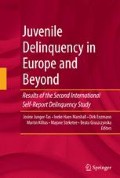Abstract
The political development of the European Union with its eastward expansion of its borders has reinforced Austria’s position as the geographic centre of Europe. Austria’s territory is composed of forests (43%), land devoted to agriculture (34%) and the Alps (10%). A significant part of Austria is rural or semi-urbanised, including the alpine regions in the west and hills towards the eastern borders with Hungary, Slovakia and the Czech Republic. About two-fifth of the land space is “urbanised” with Vienna (population larger than 1 million) as the only metropolitan area. Five cities fall into the population category of 75,000 to 250,000 inhabitants, and 18 towns have a population between 20,000 and 75,000. Further, 49 towns have a population between 10,000 and 20,000, and all other towns are smaller. Austria has a population of 8.175 million inhabitants (2004). Ninety-eight per cent of the population speaks German, and there are six officially recognised cultural minority groups (Croatians, Roma, Slovaks, Slovenians, Czechs and Hungarians) who mainly live in the southern and eastern regions. Approximately three-fourth of the population is RomanCatholic, 5% are Protestant and 21% are otherwise religiously affiliated or have no religious affiliation. With regard to employment, Austria appears to be pretty “average” for western European standards (6.4%).
Access this chapter
Tax calculation will be finalised at checkout
Purchases are for personal use only
Notes
- 1.
In the analysis of the sample-data “migration background” was defined as “born in South-East-Europe, Asia, Africa or South America, or at least one parent born there”. This definition is based on the idea of lower socio-economic status and therefore does not consider migrants from North- and West Europe and Anglo-American countries.
- 2.
This measure corresponds with the measures of gang involvement used in the Euro-Gang Study.
- 3.
No tests of statistical significance were conducted, so the presented differences should be interpreted to be merely suggestive of differences.
References
Bursik, R. J. and Grasmick, H. G. (1993). Neighborhoods and Crime. New York, Lexington Books
Eder, F. (1996). Schul- und Klassenklima. Ausprägung, Determinanten und Wirkungen des Klimas an höheren Schulen. Innsbruck-Wien: StudienVerlag
Gottfredson, M. R. and Hirschi T. (1990). A General Theory of Crime. Stanford, CA: Stanford University Press
Hirschi, T. (1969). Causes of Delinquency. Berkeley: University of California Press
Lilly, J. R., Cullen F. T., Ball R. A. (2002). Criminological Theory: Context and Consequences, 3rd Edition. London: Sage Publications
Nye, F. I. (1958). Family Relationships and Delinquent Behavior. New York: Wiley
Reckless, W. C. (1967). The Crime Problem, 4th Edition. New York: Appleton-Century Crofts
Wikström, P. O. H. (2006). Individuals, settings and acts of crime: situational mechanisms and the explanation of crime. In: Wikström P. -O. and Sampson R. J. (Eds.) The Explanation of Crime:Context, Mechanisms and Development. Cambridge: Cambridge University Press
Author information
Authors and Affiliations
Corresponding author
Editor information
Editors and Affiliations
Rights and permissions
Copyright information
© 2010 Springer Science+Business Media, LLC
About this chapter
Cite this chapter
Stummvoll, G.P., Kromer, I., Hager, I. (2010). Austria. In: Junger-Tas, J., Marshall, I., Enzmann, D., Killias, M., Steketee, M., Gruszczynska, B. (eds) Juvenile Delinquency in Europe and Beyond. Springer, New York, NY. https://doi.org/10.1007/978-0-387-95982-5_7
Download citation
DOI: https://doi.org/10.1007/978-0-387-95982-5_7
Published:
Publisher Name: Springer, New York, NY
Print ISBN: 978-0-387-95981-8
Online ISBN: 978-0-387-95982-5
eBook Packages: Humanities, Social Sciences and LawSocial Sciences (R0)

